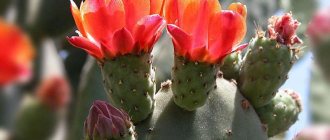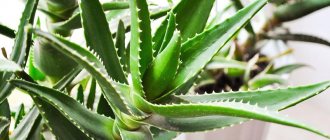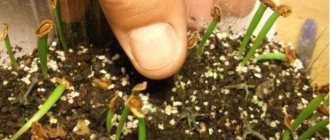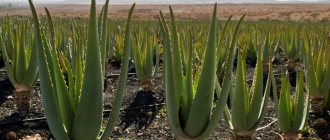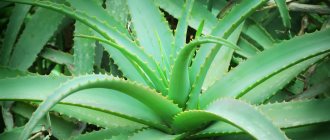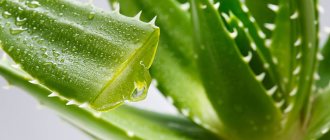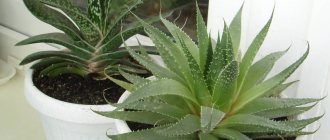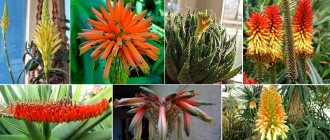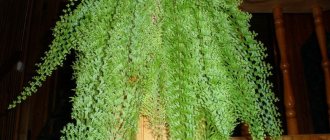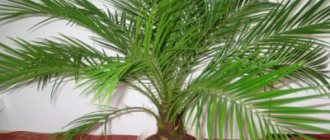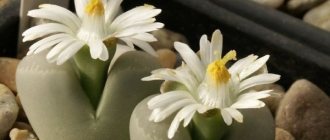Aloe Vera - description of the species
Aloe Vera means "Aloe True". The Latin word aloe is translated as “bitter”, the Greek άλός is salt (the plant juice tastes like sea water), the Arabic alloeh is a substance with a pronounced bitter taste.
Aloe as a medicine has been accompanying humans for four thousand years. This is confirmed by cuneiform writing on Sumerian tablets dating back to 2100 BC. e. However, images of this plant were also found on the walls of ancient Egyptian temples built 4 thousand years BC.
Everything, including the appearance and biological characteristics of Aloe itself, suggests that the plant first appeared in hot and dry Africa, and then spread to all other continents. In the wild, it is found on the Arabian Peninsula, Madagascar, the Canary Islands, and North Africa.
Aloe Vera forms a bush with a short stem. The roots are poorly developed. The leaves are long (up to 60 cm), fleshy, covered with thorns along the edges. Many people mistakenly call this succulent a cactus because it can also accumulate and store water. Thanks to this ability, Aloe Vera survived severe climate changes on Earth and today still serves people. In extreme situations, the pores on the skin close, and moisture is retained in the leaves for a long time.
There are 500 species of aloe in nature, but only 5 of them are considered medicinal. Aloe Vera occupies a leading position in this top five; it brings maximum benefits to humans. Growing it is a profitable business. Entire plantations are planted, and there are processing plants.
Aloe vera is considered the most valuable for its medicinal properties among more than half a thousand species of aloe.
Today, this is the only plant that treats burns from the strongest light radiation generated by an atomic explosion. Thus, this ancient natural remedy can be called a miracle of modern times.
Aloe Vera propagation methods
Rooting leaf cuttings
Planting materials are taken from different parts of the plant, but are rooted using the same technology.
- Carefully break off the leaf as close to the ground as possible. It should be at least 5–10 cm high.
- We place it in a dark place in the apartment for a day so that the wound dries and heals. You can dip the tear area in crushed charcoal to disinfect.
- Then we bury the leaf in wet sand to a depth of 1 cm. Do not spray the plant and cover it with a jar or film! It is important that only the sand remains wet at all times. After two weeks, Aloe Vera should take root. This can be understood by a more intense green color; a new leaf will appear.
Aloe vera does not have a stem as such, so only the leaf with the base can be rooted separately
We propagate by children (root shoots)
When babies appear at the base of the mother plant - small plants 5-10 cm high with 2-3 leaves, you can use them as planting material. There are two ways to separate them:
- completely remove the mother plant along with the roots, shoots and soil from the pot, carefully disconnect the children along with the roots and plant the plants;
- Carefully dig out the shoots from the pot, without handling the adult plant and trying not to damage the roots.
This is what an adult plant looks like, which has produced shoots suitable for moving to other pots
Growing from seeds
In principle, aloe can be grown from seeds, but this is a long and painstaking process.
- Prepare the soil: 1 part leaf soil (peat), 2 parts turf soil, 2 parts river sand.
- We sow the seeds in early spring. You can lightly sprinkle them with soil or simply press them into the soil.
- We carefully monitor the sowing; the sand should always be moist. The optimal germination temperature is 20 ºC.
- When the first shoots appear, you need to move the plant to a bright window or illuminate it with a fluorescent lamp.
- In the phase of 2–3 leaves, we dive into separate pots.
Aloe Vera seeds are easy to purchase from stores that sell indoor plants.
Aloe shoots ready for picking
Pruning and replanting
Many will confirm that aloe grows quickly in a pot and a small bush turns into a spreading bush. In order for the succulent to look neat and impressive, it is recommended to trim it periodically.
How to prune aloe correctly?
When pruning, you should use sharp tools: pruners or a medical scalpel. You can trim the tops of the succulent and the side shoots.
By the way, cut leaves can be used for cosmetic or medical purposes, or new specimens can be grown.
In young aloe, the root system is not yet developed, so it is recommended to replant the succulent annually.
How to determine the age of aloe?
The older the specimen, the more leaves it has. Mature plants have a more saturated leaf color, closer to dark green or dusty green. Young succulents have a brighter color. It is also better to transplant after purchasing in a store.
Beginning flower growers are wondering how to transplant aloe into another pot?
First you need to prepare a new pot, which will be larger in size than the old one. You also need suitable soil for aloe. Before replanting, be sure to fill the new pot with a drainage layer.
Caring for Aloe Vera at home
- Lighting. The plant came to us from sunny Africa, so it loves light. Keep it on a window facing south. In the warm season, take it out onto the veranda, balcony or other room that is bright but not flooded by rain.
- Temperature. Aloe Vera grows well at room temperature (18-22ºC, maximum 30ºC). In winter, it is necessary to either reduce this indicator to 12–14ºC (minimum 10ºC), or illuminate it with a lamp.
- Watering. Aloe is watered moderately when the top layer of soil dries. Water should not fall on the leaves or flow into the outlet.
- Air humidity. Dry air is preferred; spraying the plant is not recommended. If dust or dirt appears on the leaves, remove it all with a damp cloth.
- Feeding. Fertilizers are applied from March to October once every 1–2 months. Stores sell complex fertilizers recommended for all indoor plants, as well as for cacti and succulents (FORTE, Good Power and others).
Aloe Vera is famous for its excellent drought resistance and immunity to varying degrees of humidity; it tolerates the winter heating season well, when the air in apartments is very dry. But excess moisture can lead to rotting of the outlet.
Aloe can be fed with universal fertilizers for all indoor plants or special ones for succulents
Try proven drugs:
